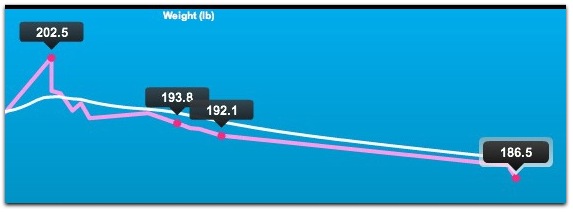From June 13 to July 21, I lived in France. This was the longest I had been out of the country, ever. And, while I loved just about everything about being there, what I’m liking best at the moment is what I failed to take back with me: about ten pounds of fat.
I still wiegh too much. My Withings scale, which produced the graph above, says I’m still carrying around about fifty pounds of fat, with a body mass index of 28.3.
I weighed about 140 when I got out of high school, and about 150 when I got out of college. I gained slowly after that. Except for a couple of diets (McDougal and Atkins), each of which knocked off about 25 pounds, my weight went steadily up. So, on the advice of tweets from @bobmetcalfe, I got the Withings, and started just paying attention. I began on March 26 at 196.2 pounds. I didn’t do much to change my eating habits, though, and I pretty much stayed even. Then, before heading to France, I started purposely eating a bit less. Going without. That’s where you see the decline to 192.1 before we left.
What was different about France? Here ya go:
- No breakfast. Usually one of us went to the corner bakery for a baguette, and I’d have a hunk of that, and not always with butter.
- Not much lunch either. We’d eat one sometimes, but we were usually too busy.
- Great dinners, late at night, by U.S. standards. Peak dinner time in France is 9pm. For the most part we were on what we called “Icelandic Time.” We’d dine late, catch up with the East and West Coasts on our computers after we got back, turn in about 1-2am, and sleep late. The dinners, of course, were full of fat and carbs, but on the whole were just good food. And without the default American obligation to engorge one’s self.
- Experimentation. The best tasting anything I had there was rongnon* d’agneau: lamb testicles. My wife talked me into them, at a restaurant that specialized in offal.
- Wine. My body doesn’t like alcohol much, though I do enjoy drinking it. But in France I had wine with most of my meals. Not sure what difference that made, but it was a difference in behavior.
- No crap food. We ate no chips, no soft drinks (except for the occasional Orangina), no dips. No burgers from McDonalds. No milk shakes. Not much that’s “processed,” as they say, far as I know.
- Lots of cheese. France is fromage as much as it is vin.
- Walking. Even though we took public transportation to most of the places we went, we also walked a lot — probably several miles per day.
- Sweating. Air conditioning isn’t valued or practiced much, at least in the older parts of Paris. And certainly not in the Metro or the RER, the two main underground trains there. Our apartment there also didn’t have it, though it stayed relatively cool with its thick stone walls (the structure dates from the 1600s) and shade. And it was quite hot most of the time I was there.
After we got back, we went shopping. On the list went lots of fruit and off of it went breakfast sausage and other former staples, mostly of the crap food variety. My appetite for them is gone, at least for now. Meanwhile, I like getting into pants I outgrew last year. Next steps: getting into the pants from two years ago, then five years ago…
* This is how I remember it, though I’m told that rognons are kidneys. Maybe somebody can correct me. I know the menu did not say testicules, which is the literal translation. By whatever name, they were lamb nuts.

Leave a Reply